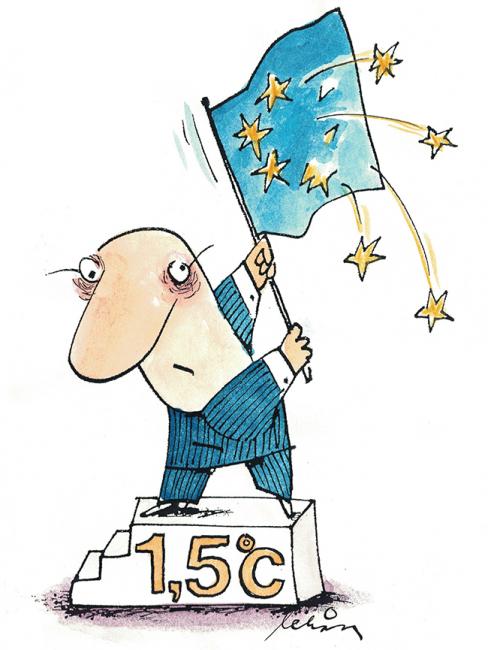Paris Agreement compatible scenarios need the EU to do much more to reduce emissions and increase renewables and energy savings.
In June of 2020 a large consortium of NGOs, led by Climate Action Network (CAN) Europe and the EEB, published an innovative, bottom-up energy scenario for the European Union which showed how the EU and its member states could transform their energy system, in line with the targets of the Paris Agreement. This Paris Agreement Compatible (PAC) energy scenario1 mapped out how the EU could phase out fossil fuel consumption between 2030 and 2040, reduce greenhouse gas emissions by at least 65% by 2030 and achieve net zero emissions by 2040, by rapidly moving to 100% renewables, drastically reducing energy consumption to half current levels and a substantial electrification of our economy.
The scenario was developed by NGOs and other experts on the basis of existing studies, dedicated workshops and some basic testing. In September a new report was published written by climate scientists at Climate Analytics, in which they analysed a number of Integrated Assessment Models from the database of the Intergovernmental Panel on Climate Change (IPCC). The IPCC in its very recently published Sixth Assessment Report listed 97 models that allow temperature rise to be limited to the 1.5°C target of the Paris Agreement with no or limited overshoot (this is important as the IPCC also indicated that even slightly going beyond 1.5°C for a short period of time can have irreversible impacts).
Climate analytics in its report (1.5°C Pathways for EU27: Achieving the highest plausible climate ambition2 ) looks specifically at three least-cost, technically feasible scenarios produced by the Integrated Assessment Modelling framework REMIND. These three scenarios focus on: an exceptionally high integration of renewables (the HighRE scenario); exceptionally high synergies with the Sustainable development Goals, and subsequent high levels of energy and resource efficiency (the SusDev scenario); and a more generic but ambitious socioeconomic pathway (the SSP1 scenario).
In its report, Climate Analytics downscales these three scenarios to the EU and compares the results with the PAC scenario. The report’s analysis enables an assessment of whether the EU’s current targets are aligned with limiting warming to 1.5°C. The report finds that, to be 1.5°C compatible, the EU would need to cut its domestic emissions faster than currently planned.
In order to realise 1.5°C compatible pathways, the following targets should be met:
• By 2030: greenhouse gas emission reductions (excl. land-based emissions and removals) of 63–73% below 1990 levels. This is substantially above the 52.8% target currently in the EU’s 2030 target (which rises to 55% if land-based emissions and removals are included);
• Net-zero greenhouse gas emissions to be achieved between 2040 and 2045. This is substantially earlier than the 2050 target in the EU Climate Law. The report thus clearly indicates that current EU climate targets cannot be seen as compatible with the Paris Agreement and its 1.5°C temperature target. The report also demonstrates how the EU could achieve these 1.5°C compatible benchmarks through a rapid transition to an efficient and electrified energy system based on renewable energy.
Based on a more detailed assessment of the HighRE and the PAC scenario, the report makes the following assessment of what this would require:
• High electrification: electricity to provide 66–70% of final energy in 2050;
• Key but limited role for hydrogen: providing 5–11% of final energy demand by mid-century; • Large-scale demand reduction: strong and sustained reductions in final energy demand, which means that by 2050, total energy demand in the EU can be up to 55% lower than in 2019;
• High level of renewables: overall renewables provide 48–54% of final energy demand in 2030, rising to 92–100% of final energy by 2050. In both pathways, fossil fuels are rapidly displaced from the energy system, with particularly strong action in the power sector, where rapid deployment of wind and solar is the cornerstone of the energy transition.
Key milestones for the power sector include:
• Coal phased out of power generation by 2030;
• Fossil gas phase out by the mid-2030s;
• 100% renewable electricity by the mid-2030s.
All in all, the Climate Analytics report clearly shows that with completely different methodologies (top-down vs bottom-up; least-cost vs cost-agnostic; ...), 1.5°C compatible scenarios come to very similar conclusions: the current EU climate and energy targets and policies as developed in the EU’s NDC (Nationally Determined Contribution to the Paris Agreement), Climate Law, Fit for 55 package and REpowerEU proposal, cannot be considered compatible with the Paris Agreement and its overall long-term objective to limit temperature rise to 1.5°C by the end of the century.
EU decision makers should have the guts to admit this and stop claiming they are fulfilling the Paris Agreement. More action and more ambition are needed.
Wendel Trio
2 The report is part of a collaboration between Climate Analytics, Airclim and CAN Europe, and funded by the Swedish Postcode Foundation.
Link to the study: https://caneurope.org/eu-canachieve-climate-neutrality-a-decade-earlier-...



































